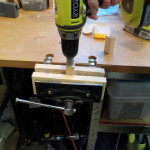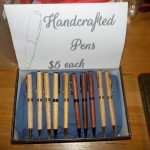Andrew, my eldest son, was enrolled in a competition recently by his school. The competition is called the $20 boss, and is run by the National Australia Bank, which is one of the largest banks around here. The basic idea is that the bank loans each of the students $20, with which they start a business. The goal is to make a profit, with the bank expecting to be returned $21. 10% of money over that should go to charity, and the rest is the student’s to keep.
Other kids seem to have chosen to make muffins, cookies, or drinks. Well, except for the kids who made candles. Andrew on the other hand had a think, and decided to ask me to teach him to make wood turned pens. This was exciting to me as Andrew hasn’t previously shown a particular interest in wood craft.
It was important to me that Andrew understand the actual economics involved, so the pens cost him about $2 to make — $1.90 for pen components, and about 7 cents for wood. The wood was priced at the commercial rate of $3,500 a cubic meter, but there’s so little wood in a pen that its basically noise, especially as all these pens were made from scrap I had lying around the workshop.
For this exercise we ignored the cost of tool wear and tear, glues, abrasives and so forth. That might have to change for reasons which will become obvious later in this post.
Andrew, his mum and I had a long talk about how to price his pens before deciding that $5 was a fair price. Interestingly there were kids at school who asserted that he couldn’t sell something that expensive, and there was pressure to lower the price. Andrew and I dug our heals in, and stuck with $5.
Here are some pics of the pen production process, as well as the finished product:
So how did it go on the day? Well, AJ had sold about half his pens before he even got to the fair at the school. Importantly, this wasn’t us propping him up — he forgot the pens when he left for school, so mum had to drop them off at the front office. The front office lady bought a pen when she saw them, and then all the back office staff wanted to buy one too. Andrew could have sold more then, but he really wanted to have some at the fair.
The rest sold out at the fair, and now Andrew has a list of orders from people who missed out on the day. There are a couple more weeks of the challenge left, so he’s now in the process of churning profit back into making more stock. That said, his mum also posted on Facebook about the challenge, and there were dozens of orders made there that we haven’t even figured out how to fulfil yet — Andrew might yet have to employ his younger brother to help!
On the pricing front, Andrew now gets to learn about how to price a product — he has data that the market is willing to pay more than he’s charging, but what’s a fair price for a pen? I suspect we’ll end up around the $10 mark, but that’s not really decided yet.
Overall, I’m crazy proud of Andrew — for not taking the easy path, for not giving in to pricing pressure, and finally for kicking butt. I suspect he’s accidentally found a way to earn himself some more pocket money for his teenage years. We’re going to need a bigger workshop.
Thanks to the National Australia Bank for running this competition. It was unexpected to me, but has turned out super well for Andrew.
Want to buy a pen made by a precocious teenager? Email me at mikal@madebymikal.com and we can talk.






Bearing in mind with orders received to date will have him busy through the next holidays 🙂